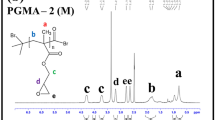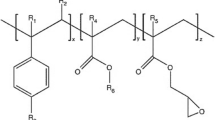Abstract
Characterized by high strength to unit weight, poly(ethylene terephthalate) (PET) remains one of the most widely used engineering plastics, hence the attention to its associated waste and recycling technology development has been paid from academic and industrial perspectives. Herein, we investigate the mechanical degradation of PET through degradative compounding process cycles and the effect of chain extender (Joncryl® ADR 4468) to prevent molecular degradation of PET during melt processing. They are characterized based on rheological and mechanical measurements. Characterization of the bottle-grade PET samples reveals low viscosity and crystallinity owing to isophthalic acid units within the PET copolymer structure over PET homopolymer. Mechanical shear and thermal impact by virtue of the increase in rotor speed and temperature are employed to study the degradation of the PET samples. Both samples respond to degradation in successive processing cycles with as much as 70% decrease in their complex viscosity and moduli. The molecular weight of PET copolymer accordingly decreases from 23,400 to 8010 g/mol. Chain scission arising from thermo-mechanical degradation results in high crystallinity by more than five folds in the processed PETs. Attributed to recoupling of the degraded short chains, the chain extender compensates with the increase in viscosity and moduli up to 20% whilst serving to increase crystallinity but almost ineffective in appreciating mechanical performance with barely any significant variation in tensile strength and elongation at break. This study shows that mechanical shear is verified to impact a pronounced degradation on PET more than thermal action on the samples.








Similar content being viewed by others
Data availability
All datasets generated and analyzed during this study are available upon request from the corresponding author.
References
Law KL, Starr N, Siegler TR et al (2020) The US’ contribution of plastic waste to land and ocean. Sci Adv 6:1–7. https://doi.org/10.1126/sciadv.abd0288
Borrelle SB, Ringma J, Lavender Law K et al (2020) Predicted growth in plastic waste exceeds efforts to mitigate plastic pollution. Science (1979) 369:1515–1518. https://doi.org/10.1126/SCIENCE.ABA3656
Harussani MM, Sapuan SM, Rashid U et al (2022) Pyrolysis of polypropylene plastic waste into carbonaceous char: priority of plastic waste management amidst COVID-19 pandemic. Sci Total Environ 803:149911
Panowicz R, Konarzewski M, Durejko T et al (2021) Properties of polyethylene terephthalate (PET) after thermo-oxidative aging. Materials 14:3833. https://doi.org/10.3390/MA14143833
Hadiyanto H, Muslihuddin M, Khoironi A et al (2022) The effect of salinity on the interaction between microplastic polyethylene terephthalate (PET) and microalgae Spirulina sp. Environ Sci Pollut Res 29:7877–7887. https://doi.org/10.1007/s11356-021-16286-z
Zimmerman H, Kim NT (1980) Investigations on thermal and hydrolytic degradation of poly(ethylene terephthalate). Polym Eng Sci 20:680–683. https://doi.org/10.1002/PEN.760201008
Hosseini SS, Taheri S, Zadhoush A, Mehrabani-Zeinabad A (2007) Hydrolytic degradation of poly(ethylene terephthalate). J Appl Polym Sci 103:2304–2309. https://doi.org/10.1002/app.24142
Venkatachalam S, Nayak SG, Labde JV et al (2012) Degradation and recyclability of poly (ethylene terephthalate). Polyester. https://doi.org/10.5772/48612
Härth M, Kaschta J, Schubert DW (2015) Rheological study of the reaction kinetics in a poly(ethylene terephthalate) melt. Polym Degrad Stab 120:70–75. https://doi.org/10.1016/j.polymdegradstab.2015.06.001
Zhang A, Wang W, Dong Z et al (2022) Mechanical, thermal stability, and flame retarding properties of phosphorus-modified PET blended with DOPO-POSS. ACS Omega 7:46277. https://doi.org/10.1021/ACSOMEGA.2C04628
Zhao Z, Wu Y, Wang K et al (2020) Effect of the trifunctional chain extender on intrinsic viscosity, crystallization behavior, and mechanical properties of poly(ethylene terephthalate). ACS Omega 5:19247–19254. https://doi.org/10.1021/acsomega.0c02815
Incarnato L, Scarfato P, di Maio L, Acierno D (2000) Structure and rheology of recycled PET modified by reactive extrusion. Polymer (Guildf) 41:6825–6831. https://doi.org/10.1016/S0032-3861(00)00032-X
Raffa P, Coltelli MB, Savi S et al (2012) Chain extension and branching of poly(ethylene terephthalate) (PET) with di- and multifunctional epoxy or isocyanate additives: an experimental and modelling study. React Funct Polym 72:50–60. https://doi.org/10.1016/J.REACTFUNCTPOLYM.2011.10.007
Jang JY, Sadeghi K, Seo J (2022) Chain-extending modification for value-added recycled PET: a review. Polym Rev 62:860–889
Shin BY, Han DH (2017) Viscoelastic properties of PLA/PCL blends compatibilized with different methods. Korea Aust Rheol J 29:295–302. https://doi.org/10.1007/S13367-017-0029-8/METRICS
Pandey V, Seese M, Maia JM, Schiraldi DA (2020) Thermo-rheological analysis of various chain extended recycled poly(ethylene terephthalate). Polym Eng Sci 60:2511–2516. https://doi.org/10.1002/PEN.25488
Duarte IS, Tavares AA, Lima PS et al (2016) Chain extension of virgin and recycled poly(ethylene terephthalate): effect of processing conditions and reprocessing. Polym Degrad Stab 124:26–34. https://doi.org/10.1016/j.polymdegradstab.2015.11.021
Tavares AA, Silva DFA, Lima PS et al (2016) Chain extension of virgin and recycled polyethylene terephthalate. Polym Test 50:26–32. https://doi.org/10.1016/j.polymertesting.2015.11.020
Jasmee S, Omar G, Masripan NAB et al (2018) Hydrophobicity performance of polyethylene terephthalate (PET) and thermoplastic polyurethane (TPU) with thermal effect. Mater Res Express. https://doi.org/10.1088/2053-1591/aad81e
Awaja F, Pavel D (2005) Recycling of PET. Eur Polym J 41:1453–1477. https://doi.org/10.1016/J.EURPOLYMJ.2005.02.005
Holland BJ, Hay JN (2002) The thermal degradation of PET and analogous polyesters measured by thermal analysis–fourier transform infrared spectroscopy. Polymer (Guildf) 43:1835–1847. https://doi.org/10.1016/S0032-3861(01)00775-3
Schyns GZO, Shaver MP, Schyns GZO, Shaver MP (2021) Mechanical recycling of packaging plastics: a review. Macromol Rapid Commun 42:2000415. https://doi.org/10.1002/MARC.202000415
Gryn’ova G, Hodgson JL, Coote ML (2010) Revising the mechanism of polymer autooxidation. Org Biomol Chem 9:480–490. https://doi.org/10.1039/C0OB00596G
Villain F, Coudane J, Vert M (1994) Thermal degradation of poly(ethylene terephthalate) and the estimation of volatile degradation products. Polym Degrad Stab 43:431–440. https://doi.org/10.1016/0141-3910(94)90016-7
Yang Z, Xin C, Mughal W et al (2018) High-melt-elasticity poly(ethylene terephthalate) produced by reactive extrusion with a multi-functional epoxide for foaming. J Appl Polym Sci 135:45805. https://doi.org/10.1002/APP.45805
Standau T, Nofar M, Dörr D et al (2022) A review on multifunctional epoxy-based Joncryl® ADR chain extended thermoplastics. Polym Rev 62:296–350. https://doi.org/10.1080/15583724.2021.1918710
Dolatshah S, Ahmadi S, Ershad Langroodi A, Alavi A (2022) Long-chain branching of polyethylene terephthalate: rheological/thermal properties of polyethylene terephthalate/carbon nanotube nanocomposite. Polym Eng Sci 62(7):2322–2334. https://doi.org/10.1002/PEN.26012
Tiwary P, Kontopoulou M (2018) Rheological characterization of long-chain branched poly(lactide) prepared by reactive extrusion in the presence of allylic and acrylic coagents. J Rheol (N Y N Y) 62:1071. https://doi.org/10.1122/1.5025817
Jiang Z, Guo Z, Zhang Z et al (2019) Preparation and properties of bottle-recycled polyethylene terephthalate (PET) filaments. Text Res J 89:1207–1214. https://doi.org/10.1177/0040517518767146
Wu W, Sun X, Chen Q et al (2022) (2022) Recycled poly(ethylene terephthalate) from waste textiles with improved thermal and rheological properties by chain extension. Polymers 14:510. https://doi.org/10.3390/polym14030510
Acknowledgements
This work was supported by the National Research Foundation of Korea (NRF) grant funded by the Korean government (MSIP) (No. 2020M3H7A1098305).
Author information
Authors and Affiliations
Corresponding author
Ethics declarations
Conflict of interest
The authors declare no competing conflict of interest.
Additional information
Publisher's Note
Springer Nature remains neutral with regard to jurisdictional claims in published maps and institutional affiliations.
Rights and permissions
Springer Nature or its licensor (e.g. a society or other partner) holds exclusive rights to this article under a publishing agreement with the author(s) or other rightsholder(s); author self-archiving of the accepted manuscript version of this article is solely governed by the terms of such publishing agreement and applicable law.
About this article
Cite this article
Saabome, S.M., Lee, J.E., Hong, J.S. et al. Mechanical degradation of poly(ethylene terephthalate) and its structural modification by chain extender. Korea-Aust. Rheol. J. 35, 203–212 (2023). https://doi.org/10.1007/s13367-023-00059-w
Received:
Revised:
Accepted:
Published:
Issue Date:
DOI: https://doi.org/10.1007/s13367-023-00059-w




